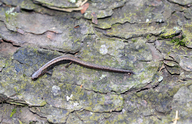|
Description
This is a large and robust species; adult standard length averages 23.5 mm in 10 males (range 21.2-24.9) and 24.8 mm in 10 females (range 22.8-27.4). The head is moderately wide, but there is no conspicuous constriction between the head and trunk; SL averages 7.4 times head width in males (range 6.8-7.9) and 7.6 times head width in females (range 7.1-8.2). Snouts are bluntly pointed. Nostrils are relatively small and oval; the mean ratio of major axis to minor axis is 1.6 in males (range 1.4-1.7) and 1.5 in females (range 1.3-1.8). The eyes do not protrude beyond the margin of the jaw in dorsal view. A suborbital groove intersects the lip on each side of the head. There are 1-2 premaxillary teeth in males (mean 1.9) and 0-5 in females (mean 2.6). Vomerine teeth average 5.7 in males (range 3-8) and 6.0 in females (range 5-7). There are no maxillary teeth. Limbs are relatively short; limb interval averages 4.9 in males (range 4.5-5.5) and 5.8 in females (range 5.5-6.5). Feet are relatively narrow. The two middle fingers and three middle toes are much longer than the outer digits; the longest digits have discrete subterminal pads. Digit tips are bluntly rounded; only the tips of the longest digits are free (unwebbed). The tail is rounded in cross section and relatively long, typically exceeding standard length; mean SL divided by tail length equals 0.82 in males (range 0.76-0.93) and 0.81 in females (range 0.73-0.95). There is a prominent parotoid gland. Coloration in life, based on field notes by J. Hanken for MVZ 183141-62 and 186944-57 (10 km E San Felipe): There is a variably colored dorsal stripe ranging from olive, to brick, to tan. The venter is dark but somewhat translucent, with fine, white speckling that is more abundant ventrolaterally than along the midline. For MVZ 183211-16 (3.2 km S Puerto del Aire): The dorsal stripe is brick-red (most specimens) or greenish (Hanken and Wake 1998). Distribution and Habitat
Country distribution from AmphibiaWeb's database: Mexico
Thorius troglodytes is known from the vicinity of the type locality near Puerto del Aire, which is ca. 3 km W of the village of Acultzingo, Veracruz, Mexico, and from localities 10-12 km E of the village of San Felipe, Puebla, southeast of the type locality. All known localities lie within Veracruz but are very close to the border with Puebla. Recorded elevations range from 2380 to 2800 m. It is an exclusively terrestrial species. According to field notes by J. F. Lynch (21 Jan. 1974), the locality at 4 km S of Puerto del Aire is a pine-oak forest; salamanders were abundant under wood chips as well as under and inside logs, under the bark of logs, and under rocks. According to J. Hanken (2 and 6 Feb. 1976), the locality at 12 km E of San Felipe comprised steep canyon slopes adjacent to cleared fields. The slopes were covered with mixed pine and chaparral vegetation, where salamanders were taken from under fallen logs, rocks, and wood chips. There was a more mesic pine-oak forest at 10 km E of San Felipe, where salamanders were collected from under fallen logs and among the soil of the road bank. See the description of T. magnipes for additional habitat notes (Hanken and Wake 1998).
References
Hanken, J. and Wake, D. B. (1998). ''Biology of the tiny animals: Systematics of the minute salamanders (Thorius: Plethodontidae) from Veracruz and Puebla, Mexico, with descriptions of five new species.'' Copeia, 1998(2), 312-345.
Originally submitted by: David B. Wake (first posted 2000-11-08)
Edited by: M. J. Mahoney (2002-02-18)Species Account Citation: AmphibiaWeb 2002 Thorius troglodytes <https://amphibiaweb.org/species/4215> University of California, Berkeley, CA, USA. Accessed May 9, 2025.
Feedback or comments about this page.
Citation: AmphibiaWeb. 2025. <https://amphibiaweb.org> University of California, Berkeley, CA, USA. Accessed 9 May 2025.
AmphibiaWeb's policy on data use.
|



 Raffaëlli Account
Raffaëlli Account Map of Life
Map of Life